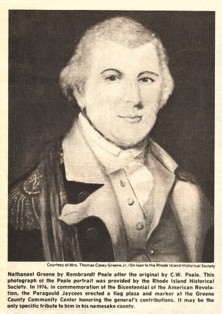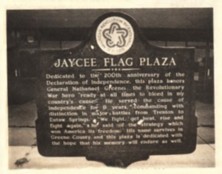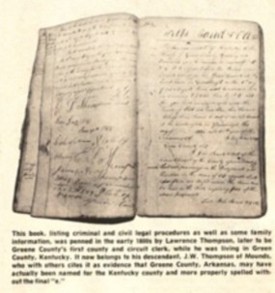
Nathanael Greene by Rembrandt Peale after the original by C.W. Peale.
This photograph of the Peale portrait was
provided by the Rhode Island Histor-ical Society. In 1976, in
commemor-ation of the Bicentennial of the Ameri-can Revolution, the
Paragould Jaycees erected a flag plaza and a marker at the Greene County
Community Center honoring the general's contributions. It may be the
only specific tribute to him in his namesake county.

JAYCEE
FLAG PLAZA
Dedicated to the 200th anniversary of the Declaration of Independence,
this plaza honors General Nathanael Greene, the Revolutionary War hero
"ready at all times to bleed in my coun-try's cause" He served the cause
of Independence for 8 years, comman-ding with distinction in major
battles
from Trenton to Eutaw Springs. "We fight, get beat, rise and fight
again," he said of the strategy which won America
its freedom. His name survives in Greene County and this plaza is dedi-
cated with the hope that his memory will endure as well.
*** ==================== ***
Top photo courtesy of: Mrs. Thomas Casey Greene Jr./On loan to the Rhode Island Historical Society.
created by the 8th Arkansas Territorial General Assembly in 1833, there's been some disagree-ment about the spelling and deriva-tion of the county's name. Even the 1833 legislators disagreed.
On Oct. 18, 1833, 11 days after the assembly had convened in Little
Rock, J.B. Hammond, one of two
Lawrence County representatives,
presented a petition from a group of his constituents seeking the cre-ation of a new county.
On Oct. 22, a bill was introduced to divide Lawrence County and under the name, "An Act to Estab-lish the County of Green," it passed the House on Oct. 28.
The bill was sent to the upper
chamber, then called the Legislative
Council, on Oct. 29 and two days later that body adopted an act "for the creation of Greene County."
Gov. John Pope approved "An Act
to Erect and Establish the County of Green" on Nov. 5, 1833. It was the 28th county to be formed in the Territory of Arkansas.
The majority opinion holds that the
county was named for Nathanael
Greene, a Revolutionary War general known as "the Savior of the South" because of his successful campaign against the British in the southern colonies. Greene was a brilliant military strategist, consid-ered second only to George Wash--ington.
Celebrated in his day as a war hero, especially by grateful South-erners, Greene died only a few years after the fighting ended. "Nathanael Greene has always been considered among the great of the American Revolution," a modern biographer wrote.
"Time, however, has dimmed remembrance of the part he played in the winning of independence and the forging of the new nation." Even British historians have lauded him as a skillfull general, citing his "patience, reslution and profound common sense."
Greene died in 1786 on the Georgia plantation given him as reward for his military service; most of the residents of nearby Savannah and the surrounding countryside turned out for his funeral procession.
Benjamin Crowley, who was 63
when he settled here in 1821, was born in Virginia in 1758 but raised in Georgia, moving later to Ken-tucky and then to Arkansas by way of Missouri, according to his grand son, Benjamin H. Crowley. One Crowley genealogy says the family's Georgia plantation was four miles south of Savannah.
These Crowleys would surely have known all about their illustrious neighbor and Benjamin Crowley, who would have been 28 at the
Greene, a fifth-generation American, was born Aug. 7, 1742, in Warwick Township, Rhode Island, and worked as an anchor-smith at his family's forge.He was only 26 in 1768 when he publicly sided with rebel colonists by cir-culating petitions against the Townshend duties and helping organize boycotts of British goods. Soon after, he was elected to the colonial assembly.
Self-taught, he acquired a large personal library, a rarity in those days, and even his military strategy was first learned from books.
Although he was raised a Quaker
and hampered by a limp, Greene organized a local militia unit in 1774 and joined the Continental cause as soonas he heard of the battles at Lexington and Concord. He immediately rose to the rank of brigadier general and other pro-motions quickly followed.
Greene was active in the Revo-lution from beginning to end. He crossed the Delaware with Wash-ington and shared the winter at Valley Forge, presided at the trial and execution of British spy John Andre, Benedict Arnold's accom-plice, and set up Cornwallis for
his final defeat at Yorktown. His
battle service reads like a map of the war: Boston, Trenton, Brandy-wine, Monmouth, Guilford Court House, Eutaw Springs, among many others.
He was 38 when he assumed command of the southern army and skillfully frustrated the British with classic guerrilla tactics. "We fight, get beat, rise and fight again." he wrote his friend Lafayette. His fellow general Henry Knox said of Greene, "Without an army, without means, without anything, he has performed wonders." And Wash-ington himself praised Greene continually.
Greene, who once wrote that he was "ready at all times to bleed in my country's cause," lost most of his personal fortune when he un- derwrote a contract in order to keep his soldiers from starving. After the war, an appreciative South Carolina legislature award-
ed him a large sum of money, but most of it was used to pay the army's debts.
He died June 1786, apparently of
sunstroke, at age 43.
Nathanael Greene's name is often
misspelled, both names actually. Arkansas history books constantly refer to "Nathaniel Greene."
or Greene County, Kentucky?

This book, listing criminal and civil legal
procedures as well as some family information, was penned in the early
1800's by Lawrence Thompson, later to be Greene County's first county
and circuit clerk, while he was living in Green County, Kentucky. It now
belongs to his descendant, J. W. Thom-pson of Mounds, who with others
cites it as evidence that Greene County, Arkansas, may have actually
been named for the Kentucky county and more properly spelled without the
final "e."
***=======================***
(There was a famous man so named, but he was a Boston journalist. And
who would
name an Arkansas county for one of those?) Both the general and the
county have had their names shortened at various times to "Green."
Another view, however, holds that the shortened county version is
not an error, say-ing the name came from Green County, Ken-tucky, from
whence several early pioneers also came.
J. W. Thompson owns a hand-written
book, penned by Lawrence Thompson,
his great-grandfather and the first county clerk here. It includes a
compilation of legal procedures from the Commonwealth of Kentucky,
specifically from Green County, Kentucky.The Thompsons are convinced
that
this book was used in organizing the Greene County, Arkansas, government
in 1833 and helped provide the new county's name.
But traditionally Arkansas has named its counties after
distinguished national or local figures, many of whom are now considered
obscure.Six other counties were established in 1833 and all but
Mississippi were named for prominent men -- Charles Carroll, a signer of
the Declaration of Independence; Zebulon Pike of Pike's Peak fame;
President Martin Van Buren; Benjamin Johnson and Andrew Scott, respected
territorial judges.
In 1906, Benjamin H. Crowley, the pio-
neer's grandson, wrote straightforwardly that "Greene County was named
after Gen. Nathaniel (sic) Greene of Revolutionary fame and was for a
long time spelled without
the final 'e.' But when it was discovered in latter years that the great
general always wrote his name with the last 'e' added, the official and
correct name of the county has been with the final 'e' appended."